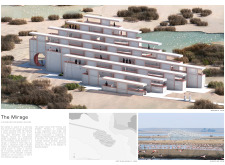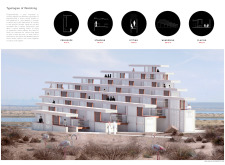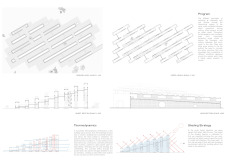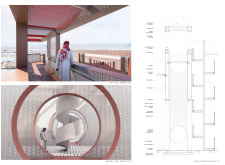5 key facts about this project
At its core, "The Mirage" is an exploration of how architecture can harmonize with nature. The design prioritizes an intrinsic relationship with the wetlands, inviting visitors to engage with the diversity of this ecosystem. The building's layout consists of stacked horizontal planes that evoke the geological formations of the desert, creating an immersive environment that encourages exploration. The architectural strategies employed in this project highlight movement and interaction, allowing visitors to experience different perspectives and engagements with the site as they traverse through varying spaces.
One of the defining features of "The Mirage" is its attention to spatial variety. The design incorporates numerous terraces and viewing platforms, each strategically placed to provide unique vantage points for observing the surrounding wetlands. These elevated spaces create dynamic opportunities for reflection and engagement with the landscape, fostering a sense of connection to the natural setting. Furthermore, the central circular element in the layout acts as a focal point, inviting visitors to gather and converse, thus enhancing community interaction within the site.
Material selection plays a critical role in the design of "The Mirage." The project employs a blend of concrete, wood, steel mesh, and painted wood cladding to achieve its desired functionality and aesthetic appeal. Concrete serves as the primary structure, providing the necessary durability. In contrast, wood is introduced to add warmth and texture, creating a more inviting atmosphere for occupants. The use of steel mesh for shading solutions improves thermal comfort while still allowing natural light to penetrate, balancing energy efficiency with aesthetic quality. Additionally, the painted wood cladding offers an appealing visual touch that complements the organic forms of the architecture.
Unique design approaches are evident throughout the project, particularly in the way it addresses environmental considerations. "The Mirage" aims to maximize natural airflow, reducing dependence on artificial cooling systems. Elements such as high albedo materials and strategic shading devices work together to optimize the building’s internal climate. The architects have designed the structure to encourage passive interaction with the environment, embodying principles of sustainability that resonate within the region’s climatic context.
The interplay of angles, textures, and openings throughout "The Mirage" further emphasizes its innovative design. Instead of delineating clear boundaries between the interior and exterior, the architecture invites the landscape in, allowing visitors to feel an immersive connection with the surrounding environment. This approach supports a seamless flow between different areas of the project, enhancing the overall experience of the space.
With its thoughtful design and integration into the natural world, "The Mirage" represents a significant contribution to contemporary architecture in Abu Dhabi. The project not only meets functional requirements but is also a catalyst for environmental engagement and community interaction. For those interested in exploring this project further, a detailed examination of the architectural plans, architectural sections, and other architectural ideas will provide deeper insights into the careful considerations that shaped this unique design. Potential visitors and architecture enthusiasts are encouraged to delve into the project presentation for a comprehensive view of the intricacies and intentions behind "The Mirage."


























